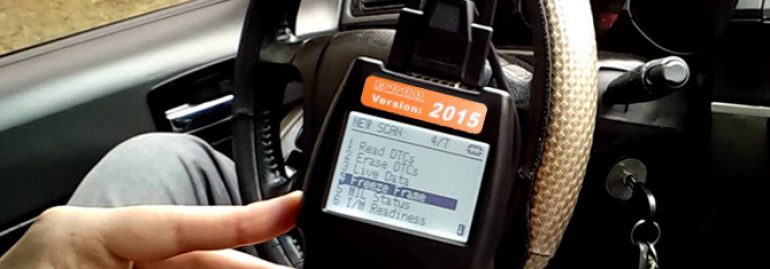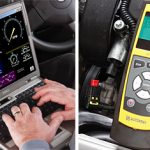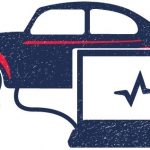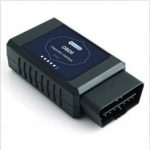What is an OBD II Scan Tool?
Before we begin to look for the things that are important while buying an OBD scanner, we must briefly understand the actual purpose of this device.
OBD stands for On board Diagnostics. OBD II Scan tool, as the name itself reveals, is the updated version of OBD I scan tool.
Its major function is to detect the problems in a vehicle and help the owner troubleshoot it.
The older version of OBD scanner used to just flash a warning signal on the dashboard of the car to warn the driver about some malfunctions in the vehicle.
But OBD II goes a few steps ahead by detecting the underlying issue through DTC (Diagnostic Trouble Codes) and by explaining what that code means and how the issue could be fixed.
OBD II specification was made mandatory in 1996 for all the vehicles manufactured in the US.
OBD II scan tool is an emission oriented device. It illuminates the MIL (Malfunction Indicator Light) whenever a vehicle’s emissions exceed 1.5 times the federal test procedure (FTP) standardized for the particular vehicle.
The MIL usually works even when there is a random misfire that increases the overall HC emissions, or the catalytic converter drops below a certain threshold, or there is a leakage in the sealed fuel system, or there is some fault in the EGR system that causes NOX emissions to rise up, or there is any key sensor or other emission control device that stops working.
The vehicle may seem to run normally with no apparent problem, but the OBD II scan tool takes action if any of such emission-related changes occur in the car. OBD II scan tool is considered to be a more authentic method than the traditional tail pipe testing system used during the emission inspection programs.
The origin of OBD II dates back to 1982 in California, when the California Air Resources (ARB) decided to lay out a plan that starting from 1988 all the vehicles will be equipped with an on-board diagnostic tool to detect emission failures.
The OBD I was quite simple. It used to monitor the oxygen, EGR system, engine control module, and fuel delivery system. It lacked the standardization between the different makes and models of the vehicles.
Therefore, when OBD II was launched, standardization was its main feature. An OBD II has a standardized 16 pin data link connector (DLC) with specific pins arranged for specific functions, standardized electronic protocols, standardized diagnostic trouble codes (DTC), and standardized terminology.
In fact, standardization has helped immensely in mandating the OBD II in all the vehicles in the US.
1 – Types
When planning to buy an OBD II Scan tool, it’s important to sort out the type of OBD tool you need. There are basically three kinds of OBD II Scan tools available in the market, as mentioned below:
- Basic Code Reader:
As the name suggests, Basic code reader detects the problem in the vehicle and flashes the DTC code for that particular problem. It does not tell what that code means and how to fix that issue. The driver has to look for the meaning of the code in the code guide book or search online for it. They help you keep a check on the accountability of your mechanic and do some basic repairs on your own. They are cheap and useful if you just want to be aware of the problems that arise on a daily basis in your vehicle.
- DIY Scanners
These Do-it-Yourself scanners usually detect DTC and tell what does that mean. They tell the exact location of the problem in the vehicle and give recommendation regarding how to fix those problems. These types of scanners are useful if you are interested in self-repairs. They are designed to be connected to smartphones or PCs for easy access of data.
- Professional Scanners
These scanners are far ahead in technology than the above two types. These are generally used by auto manufacturing companies or advanced auto service centers. They are tablet size equipment that detect the problems with just a single scan. They are majorly used to detect troubles in the large sized trucks.
Here is your checklist if you plan to buy a basic code reader:
- Low budget.
- Identification of the only DTC required.
- Matching the protocols of the device with the protocol of your vehicle.
Here is your checklist if you plan to buy a DIY OBD II scan tool:
- Be ready to spend a bigger amount of money.
- Need the DTC and the meaning of the code and effective solution to the problem.
- Want a device with advanced functions, like:
- ABS or Airbag Capability: This function helps read and reset the Antilock brake system and Airbag systems of the vehicle.
- On-Screen Definitions: It shows the definitions of the DTC right on the screen of the device.
- Print: The driver can conveniently take out the print of the results.
- Real-time error detection: The device can scan engine sensors and performance of the vehicle even while driving it.
- Updatable: The device can be updated online with changes in the vehicle protocol.
- Retrievable data: Data can be saved in the scanner’s memory for later use.
- Retrieve the VIN: VIN (Vehicle Identification Number) can also be retrieved. It helps verify the original VIN if it has been tampered.
After deciding which OBD II scan tool to buy, it is quite important to know certain things that would save you later from regretting. An extensive research before buying such an essential device for your vehicle always pays.
There are certain factors that you must consider enquiring before investing in such a high-end tool.
- Software upgrading facility: This scan device needs software to perform its functions. If the device comes with an inbuilt software, be sure to check the year in which the software was updated and which version of the software your device uses. Make sure that the device allows you to update your software and provide other support mechanisms; otherwise, after sometime, you will be left with an outdated device.
- Compatibility options: Before buying the device, it is better to decide how you want your messages to be relayed? You may want them on a laptop or to be relayed to a Bluetooth or to some other option. Make your choice according to your needs and budget so as to save yourself from hassles in the future.
- Spend wisely: Don’t get trapped in the lures of the companies that try to convince that if a company’s product is expensive than its other competitive brands, then it ought to be advanced and superior. Decide your requirements beforehand and look for those options that fulfill all your requirements in a moderate price range.
- Customer and expert reviews: Equip yourself with the authentic reviews of the customers who have been using the particular device you are planning to buy for some time. There are certain issues that only a customer can tell. The companies only tell you about the advantages of a particular device, but they won’t let you know the pitfalls of the products. Also, read the product comparisons and reviews online provided by experts to decide on the same type of products manufactured by different brands.
2 – Different Brands
There are numerous brands and models of OBD II scanners available on the market. Here’s a list of the top 10 list of brands to choose from.
Though you can go beyond this list and find a suitable option for you, this list will help you compare and contrast the brands before buying and will also inform you about the basic features and major drawbacks of these products.
- Innova 3150F:
- Easy-to-use hotkeys
- Live Customer support line
- Can upload data to laptops
- Autel AL519
- Can provide audible troubleshooting
- Data can be retrieved and printed.
- Has a storage case.
- Actron CP9680
- Provides trilingual support.
- Can read Asian and abs codes too.
- Can record and graph live engine data.
- Lemur Vehicle Monitors Blue Driver
- Can display fuel trim data.
- Can stay plugged in every time.
- Can perform smog check.
- Scan Tool 427201
- Free updates from the manufacturing company.
- 3 minutes of installation time.
- Supports eobd and jobd too.
- MAOZUA V2016
- Provides accurate code reading.
- Operates without batteries.
- Can save up to 15 scans in the memory.
- INNOVA 3100i
- Battery backed up memory.
- User-friendly diagnostic codes.
- Comes with one year warranty.
- Scan Tool 425801
- Equipped with free license key for OBDwiz software.
- Accurately reads graphs logs and export data.
- Comes with free lifetime software updates.
- Buke OBP MATE
- Detects OBD II freeze frame info.
- Equipped with live data reading function.
- Does not work on airbags and brakes.
- BAFX Products 3465
- Compatible for all the US-based vehicles manufactured in and after 1996.
- Compatible for Android and OBD based applications.
- Accurately transmits real-time rpm data.
- Inconsistent Bluetooth connection.
While there are numerous options to choose from while investing in an OBD II scan tool, it becomes quite important to look for the performance and user-friendly aspect of the tool.
Bluetooth OBD II scanners are such devices that are portable, compact and have an edge over other scanners in terms of performance. They are compatible with your inseparable smartphones and tablets, so you won’t face any compatibility issues after installing them.
You can take the benefit of free app updates, live data interactions and regular software updates through them.
3 – Usage
Using an OBD II scanner is not a cumbersome task. You have to follow a few instructions and then you will be all set to use the device. It does not require any specific mechanical knowledge to install it.
Here are a few simple steps to be followed to install it in your vehicle.
Step 1: Find your vehicle’s diagnostic or data link connector (DLC). It is a 16 pin connector that is generally located underneath the left hand side of the dashboard near the steering column.
Step 2: Insert the OBD II scanner into the DLC. It could be attached through the cables to the scanner or you can use a separate wireless device to initiate communication with your on-board computer.
Step 3: After the installation of the OBD II scanner, you will see a message showing “established data link” or “searching for protocol” which will flash on the scanner’s screen.
Step 4: Enter your vehicle’s information, like model no. and year of manufacture, VIN, and engine type. Remember, information of the vehicle sought by the scanner could vary with different brands.
Step 5: After entering all the required information, you will be all set to start searching the trouble codes.
Step 6: Browse the scanner’s menu and find out “trouble codes” or just “codes.”
Step 7: Now, check the system that you want to check for its proper functionality. Some scanners allow you to check specific functions, like transmission, brakes, airbags, power train, etc. while others don’t. The diagnostic code will be delivered to you once you check the system or if the scanner does not allow you to select a particular system, it will directly generate a diagnostic code.
Once you fix the fault in your OBD II equipped vehicle, you can check your work by performing an OBD II drive cycle. The drive cycle usually runs all the onboard diagnostics. Make sure to erase all the trouble codes from the PCM’s memory or disconnect the battery before running it.
The drive cycle runs all the system status “flags” to detect if there are any more faults in the vehicle. Don’t keep the ignition key on prior to the cold start, otherwise the heated oxygen sensor diagnostic will not run.
Beyond OBD II
At present, there are 150+ million OBD II equipped vehicles running on the roads in the US. They have increased the performance of the vehicles to a great extent.
Drivers have become well aware of the faults of their vehicles and so they are no longer duped by the mechanics, who often charge high amounts for the minor faults.
OBD II is an efficient tool that saves both time and money. The future of OBD II is convergence; i.e., to be able use Wi-Fi signals and detect a Wi-Fi enabled smartphone or laptop.
This will immensely help in monitoring the vehicle at the right time in a nearby garage or on road.
Presently, the PLX WiFi and OBDKey WLAN allow a nearby iPhone or iPod Touch to stream OBD data for use in an app, such as DashCommand or Rev.
The facilities of navigation through GPS system are also going to merge into this super device.
The newly launched Garmin Eco Routes HD system works on two parts: the wireless OBD II port dongle and the ecoRoutes firmware. The OBD II port dongle interfaces with engine computers and the vehicle’s sensors.
The firmware is available on the Nuvi 1260,1370,1390,1490 and 19690 models, and on the upcoming devices as well.
After connecting the ecoRoutes HD system to the vehicle’s OBD II scan tool, the wireless dongle transmits all the gathered info via a Bluetooth connection to a paired Nuvi navigator.
The Nuvi’s ecoroute usually gathers all the required information and then measures the fuel economy of the vehicle. It also accesses the driving habits of the driver.
It will suggest ways as to how the driving could be made more efficient and greener. Thus, it could be safely said that the future of OBD II is very bright.
It would not be a deal of loss if you plan to shell out some extra dollars to invest in a high tech OBD II device.
This will serve you as a long term investment, as you do not have to discard your older version of OBD II to buy the upgraded one.







More info about an OBD II Scantool:
Traditionally, a mechanic would hook up a obd-ii scantool to the port to read the DTC (car’s faults stored in it’s computer).
A less expensive obd ii scantool would only provide a numeric code, which the mechanic would then look up from the manufacturer’s manual or service website. More expensive scan tools provide will provide text error codes.
However, in recent years, there are more advanced scan tools for obd-ii are available for regular drivers who don’t want to have to depend on a mechanic to find out what’s wrong with their car.
One example is the OBDLink SX USB Adapter by ScanTool that lets you read the trouble codes with your laptop.
I bought an obd ii scantool to bleed the ABS module on a 99 Ford Ranger. There is a way to turn on the ABS motor and open each valve, but it’s not as simple as it is when I hook it up to my 11 Hyundai Tiburon. In the ABS options for the Tiburon, there is a clear option for auto bleed, service bleed, etc. The options are different per vehicle. Not sure about compatibility until ya try it I guess. In both cases the obd ii device helped.
So pro scanner, diy code reader or ordinary scanner. They all sound same to me just with different descriptions! Point is they all under same category: obd ii scantool. I think dividing like that creates more confusion. Customer should simply get scan tool for their specific car. Don’t need to worry about all this diy, pro, etc.
Our car garage has influx of new cars. We already use a brand-name obd ii diagnostics tool, certified by NRMA, which has world class obdii live data reporting ability.
However our obdii scan tool has been insufficient in department of obd iii.
Is there any difference between obd ii diagnostics tool and (example) obdc iii scan tool? Does later have advantage? Also will obd iii work with hybrid vehicles?
For now we’ll stick with SnapOn obdii scan tool. But already thinking about future.
So essentially Launch obd ii scantools are similar to a higher cost Actron, but with a better organized screen and simpler format. It does live feed and scans, and pulls codes with no issues. My boyfriend is a mechanic and has found himself working on a lot of used cars at the dealership. This works perfectly as an alternative to a few thousand dollar Snap-on if youre looking to pull codes and see live feed but don’t need to manipulate inputs. It doesn’t reset oil lights and you can’t use it to change data (i.e. throttle, fuel trim etc) but if you need a decent code reader and want to be able to see data its a great option for half the price of some name-brand code readers that do the same thing.
I just got a chance to try a obd ii scan on Merc GL 500. I was really happy with Acctron obd ii scan tool.
Was able to connect to both of my cards and resolve the SRS issue.
FYI the scan tool comes with a nice cloth style case to store it in. Inside the case are two pockets, one to tuck the OBD cable and the other to hold the USB charger, in case you wanted to charge it while not having it plugged into a vehicle.
I own two 2013 Chevy’s. The suburban 2500 & equinox 2.4l. I’m not looking to change any of the vehicle settings, but rather be able to use the software to diagnose my check engine light issues with real time & freeze frame data. Just want to be sure I can do that prior to spending the $$ on the obd ii scantool
At the moment, I am looking for best obd ii scantool option for small garage business.
I am looking an OBD scanning tool which can make a simple car optimizations(e.g. set the day lights automatically on, distance control and etc.) .
Your product seems appropriate for my needs.
One thing is a bit unclear for me – can I make a documentation and print for example an error list to provide it ti the customer, directly from the TOAD programme interface?
Does it give an opportunity to save the data in PDF file?